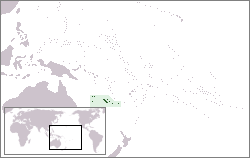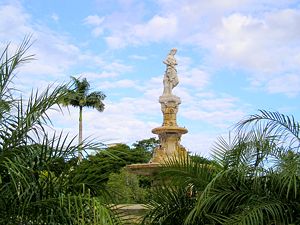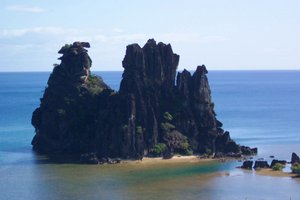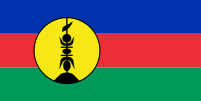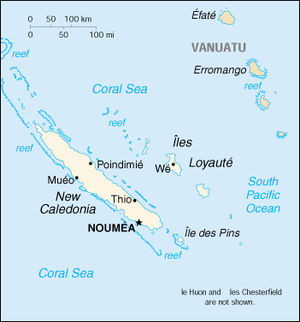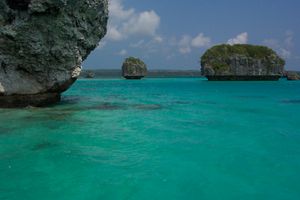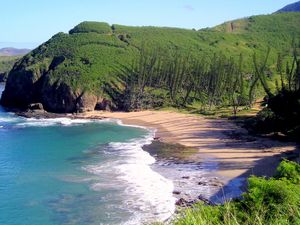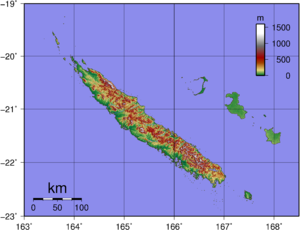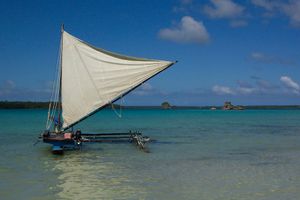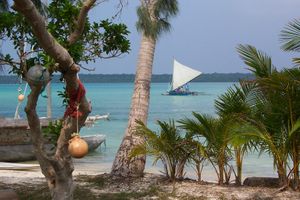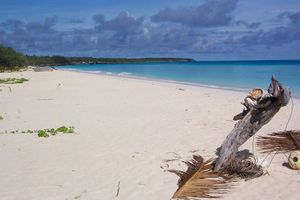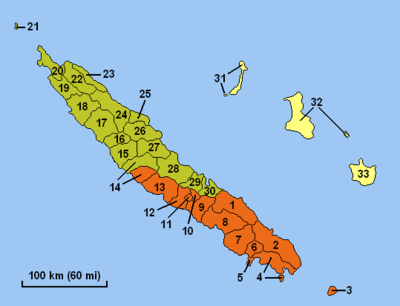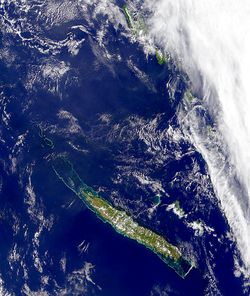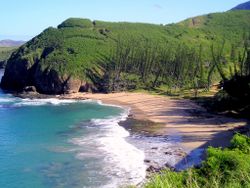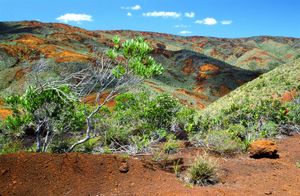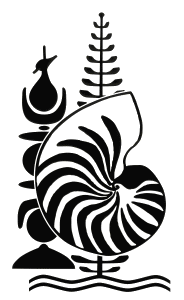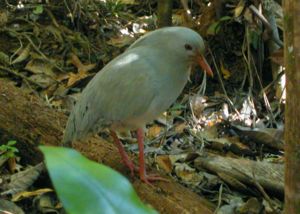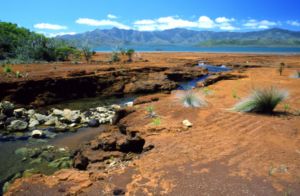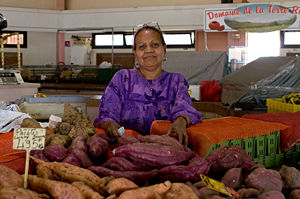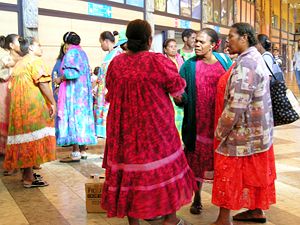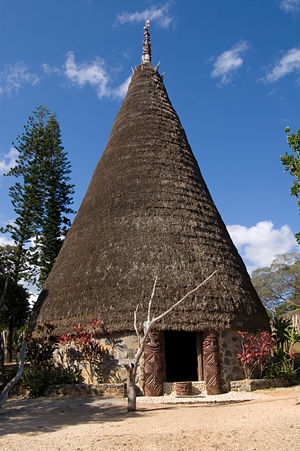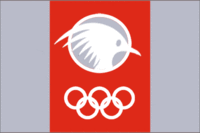New Caledonia
2008/9 Schools Wikipedia Selection. Related subjects: Geography of Oceania (Australasia)
| Nouvelle-Calédonie New Caledonia
|
||||||
|---|---|---|---|---|---|---|
|
||||||
| Anthem: La Marseillaise |
||||||
|
|
||||||
| Capital (and largest city) |
Nouméa | |||||
| Official languages | French | |||||
| Government | Overseas territory of France | |||||
| - | President of France | Nicolas Sarkozy | ||||
| - | President of the Government of New Caledonia | Harold Martin | ||||
| - | High Commissioner | Yves Dassonville | ||||
| Overseas territory of France | since 1853 | |||||
| Area | ||||||
| - | Total | 18,575 km² ( 154th) 7,359 sq mi |
||||
| Population | ||||||
| - | Jan. 1, 2008 estimate | 244,600 ( 176th) | ||||
| - | Aug./Sept. 2004 census | 230,789 | ||||
| - | Density | 13/km² ( 200th) 34/sq mi |
||||
| GDP (nominal) | 2006 estimate | |||||
| - | Total | $6.813 billion ( not ranked) | ||||
| - | Per capita | $28,568 ( not ranked) | ||||
| HDI (2003) | n/a (unranked) ( n/a) | |||||
| Currency | CFP franc ( XPF) |
|||||
| Time zone | ( UTC+11) | |||||
| Internet TLD | .nc | |||||
| Calling code | +687 | |||||
New Caledonia (French: Nouvelle-Calédonie; popular names: Kanaky, Le caillou), is a " sui generis collectivity" (in practice an overseas territory) of France, made up of a main island (Grande Terre), the Loyalty Islands, and several smaller islands. It is located in the region of Melanesia in the southwest Pacific. At about half the size of Taiwan, it has a land area of 18,575.5 square kilometres (7,172 sq mi). The population was 244,600 inhabitants as of January 2008 official estimates. The capital and largest city of the territory is Nouméa. The currency is the CFP franc.
Since 1986 the United Nations Committee on Decolonization has included New Caledonia on the United Nations list of Non-Self-Governing Territories. New Caledonia will decide whether to remain within the French Republic or become an independent state in a referendum sometime after 2014.
Its capital Nouméa is the seat of the regional organization the Secretariat of the Pacific Community (formerly the South Pacific Commission).
Origin of the name
The name Caledonia derives from the Latin name of an area corresponding to modern Scotland. The name Kanaky is also in common usage in French, English and the indigenous languages. This name is favored by Melanesian nationalists. The word comes from kanaka, a Hawai`ian word (elsewhere tangata and variants) meaning "human/person/people", used by Polynesians to refer to themselves. The word was later used by the French about all the indigenous inhabitants of the South Pacific Ocean, including the Melanesian (non-Polynesian) native inhabitants of New Caledonia. The word, turned into Canaque in French, became derogatory. In the 1960s and 1970s, when the Melanesian native inhabitants started to organize themselves into political parties and call for independence, the word was transformed into a symbol of political emancipation and pride. In 1983, during the period of political turmoil, the terms Kanak and Kanaky became political brand names and colonial whites which realized the name had changed into a political statement.
History
The western Pacific was first populated about 50,000 years ago. The Austronesians moved into the area later. The diverse group of people that settled over the Melanesian archipelagos are known as the Lapita. They arrived in the archipelago now commonly known as New Caledonia and the Loyalty Islands around 1500 BC. The Lapita were highly skilled navigators and agriculturists with influence over a large area of the Pacific.
From about the 11th century Polynesians also arrived and mixed with the populations of the archipelago.
Europeans first sighted New Caledonia and the Loyalty Islands in the late 18th century. The British explorer James Cook sighted Grande Terre in 1774 and named it New Caledonia, Caledonia being the Latin name for Scotland. During the same voyage he also named the islands to the north of New Caledonia the New Hebrides (now Vanuatu), after the islands north of Scotland.
Whalers operated off New Caledonia during the 19th century. Sandalwood traders were welcome but as supplies diminished, the traders became abusive. The Europeans brought new diseases such as smallpox, measles, dysentery, influenza, syphilis and leprosy. Many people died as a result of these diseases. Tensions developed into hostilities and in 1849 the crew of the Cutter were killed and eaten by the Pouma clan.
As trade in sandalwood declined it was replaced by a new form of trade, Blackbirding. Blackbirding was a euphemism for enslaving people from New Caledonia, the Loyalty Islands, New Hebrides, New Guinea and the Solomon Islands to work in sugar cane plantations in Fiji and Queensland. The trade ceased at the start of the 20th century. The victims of this trade were called Kanakas, a label later shortened to Kanak and adopted by the indigenous population after French annexation.
The island was made a French possession in late 1853 in an attempt by Napoleon III to rival the British colonies in Australia and New Zealand. Following the example set by the British in nearby Australia, between 1864 and 1922 France sent a total of 22,000 convicted felons to penal colonies along the south-west coast of the island; this number includes regular criminals as well as political prisoners such as Parisian socialists and Kabyle nationalists. Towards the end of the penal colony era, free European settlers (including former convicts) and Asian contract workers by far out-numbered the population of forced workers. The indigenous Kanak populations declined drastically in that same period due to introduced diseases and an apartheid-like system called Code de l'Indigénat which imposed severe restrictions on their livelihood, freedom of movement and land ownership.
During World War II, US and Allies forces built a major position in New Caledonia to combat the advance of Japan in South-East Asia and toward Australia. Noumea served as a headquarters for the United States military in the Pacific. The proximity of the territory with the South Pacific operations permitted also quick repairs in Noumea of damaged US ships. The American 23rd Infantry Division is still unofficially named Americal, the name being a contraction of "America" and "New Caledonia".
The U.S. military headquarters - a pentagonal complex - was, after the war, taken over as the base for a new regional intergovernmental development organisation: the South Pacific Commission, later known as the Secretariat of the Pacific Community.
New Caledonia has been on a United Nations list of non-self-governing territories since 1986. Agitation by the Front de Libération Nationale Kanak Socialiste ( FLNKS) for independence began in 1985. The FLNKS (led by the late Jean-Marie Tjibaou, assassinated in 1989) advocated the creation of an independent state of 'Kanaky'. The troubles culminated in 1988 with a bloody hostage taking in Ouvéa. The unrest led to agreement on increased autonomy in the Matignon Accords of 1988 and the Nouméa Accord of 1998. This Accord describes the devolution process as "irreversible" and also provides for a local Caledonian citizenship, separate official symbols of Caledonian identity (such as a "national" flag), as well as mandating a referendum on the contentious issue of independence from the French Republic sometime after 2014.
Politics
The unique status of New Caledonia is in between that of an independent country and a normal Overseas department of France.
On the one hand, both a Territorial Congress ( Congress of New Caledonia) and government have been established, and are increasingly empowered via the gradual implementation of a devolution of powers from France in favour of New Caledonia, pursuant to the 1998 Nouméa Accord. Key areas (e.g. taxation, labour law, health and hygiene, foreign trade, and others) are already in the hands of the Territorial Congress and government. Further authority will be given to the Territorial Congress in the near future. Ultimately, the French Republic should only remain in charge of foreign affairs, justice, defense, public order, and treasury. An additional enhancement to New Caledonian autonomy has come in the form of recently-introduced territorial "citizenship": Only New Caledonian "citizens" have the right to vote in local elections. The introduction of this right has been criticised, because it creates a second-class status for French citizens living in New Caledonia who do not possess New Caledonian "citizenship" (because they settled in the territory recently). Further signs of increased autonomy for the territory, include New Caledonia's right to engage in international cooperation with independent countries of the Pacific Ocean region, the continued use of a local currency (the French Pacific Franc, or CFP) rather than the Euro, as well as the authority of the Territorial Congress to pass statutes overriding French law in a certain number of areas.
On the other hand, New Caledonia remains a part of the French Republic. The inhabitants of New Caledonia are French citizens and carry French passports. They take part in the legislative and presidential French elections, sending two representatives to the French National Assembly and one senator to the French Senate. At the 2007 French presidential election the voter turnout in New Caledonia was 68.14%. The representative of the French central state in New Caledonia is the High Commissioner of the Republic (Haut-Commissaire de la République, locally known as "haussaire"), who is the head of civil services, and who sits as an integral part of the territorial government.
The Nouméa Accord provides a mechanism for the determination of the ultimate status and degree of New Caledonian territorial autonomy: Pursuant to the Accord, the Territorial Congress will have the right to call for a referendum on independence, at any time of its choosing after 2014.
The current president of the government elected by the territorial Congress is Harold Martin, from the loyalist (i.e. anti-independence) " Future Together" party (l'Avenir Ensemble), which crushed the long-time ruling RPCR (Rally for Caledonia in the Republic) in May 2004. "Future Together" is a party of mostly White and Polynesian New Caledonians opposed to independence, but rebelling against the hegemonistic and (allegedly) corrupt anti-independence RPCR, led by the now-discredited Jacques Lafleur. Their toppling of the RPCR (that was until then seen as the only voice of New Caledonian Whites) was a surprise to many, and a sign that New Caledonian society is undergoing changes. "Future Together," as the name implies, is opposed to a racial-oriented vision of New Caledonian political life, one based purely on the political primacy of either the Melanesian native inhabitants or the descendants of European settlers. Rather, it is in favour of a multicultural New Caledonia, of governing principles that better reflect the reality of the existence of large populations of Polynesians, Indonesians, Chinese, and other immigrant communities that make up the territory's population. Some members of "Future Together" are even in favour of independence, though not necessarily on the same basis as the Melanesian independence parties.
Representation at the national level
New Caledonia sends two deputies to the French National Assembly, one representing the commune (municipality) of Nouméa, the commune of L'Île-des-Pins and the Loyalty Islands Province, and the other representing the rest of New Caledonia. New Caledonia also sends one senator to the French Senate.
Geography
New Caledonia is located around in the southwest Pacific Ocean, approximately 1,200 kilometres (746 mi) east of Australia and 1,500 kilometres (932 mi) northwest of New Zealand. The island nation of Vanuatu lies to the northeast.
New Caledonia is made up of a main island, the Grande Terre, and several smaller islands, the Belep archipelago to the north of the Grande Terre, the Loyalty Islands to the east of the Grande Terre, the Île des Pins to the south of the Grande Terre, the Chesterfield Islands and Bellona Reefs further to the west.
The Grande Terre is by far the largest of the islands, and the only mountainous island. It has an area of 16,372 square kilometres (6,321 sq mi), and is elongated northwest-southeast, 350 kilometres (217 mi) in length and 50 to 70 kilometres (31–44 mi) wide. A mountain range runs the length of the island, with five peaks over 1,500 meters (4,900 ft). The highest point is Mont Panié at 1,628 meters (5,341 ft) elevation. The total area of New Caledonia is 19,060 square kilometers (7,359 sq mi), 18,575 square kilometers (7,172 sq mi) of those being land.
New Caledonia is one of the northernmost parts of a (93%) submerged continent called Zealandia. It sank after rifting away from Australia 60–85 million years ago (mya) and from Antarctica between 130 and 85 mya. New Caledonia itself is separated from Australia since 65 mya, and subsequently drifted in a north-easterly direction, reaching its present position about 50 mya.
Subdivisions
Along with other Pacific Ocean territories of French Polynesia and Wallis and Futuna, New Caledonia is part of the French Republic. Its official status, unique in the French Republic, is said to be sui generis, because New Caledonia is the only French subdivision that is not a collectivité territoriale. New Caledonia was a colony until 1946, then an overseas territory ( territoire d'outre-mer, or TOM) from 1946 to 1999. The capital is Nouméa, the only major conurbation in the territory.
Administratively, the archipelago is divided into three provinces:
- South Province (province Sud). Provincial capital: Nouméa. Population: 164,113 inhabitants (2004).
- North Province (province Nord). Provincial capital: Koné. Population: 44,596 inhabitants (2004).
- Loyalty Islands Province (province des îles Loyauté). Provincial capital: Lifou. Population: 22,080 inhabitants (2004).
It is further subdivided into thirty-three communes. One commune, Poya, is divided between two provinces. The northern half of Poya, with the main settlement and most of the population, is part of the North Province, while the southern half of the commune, with only 122 inhabitants in 2004, is part of the South Province.
| South Province | North Province | Loyalty Islands Province |
|---|---|---|
|
|
|
There are also three administrative subdivisions, simply known as subdivisions in French, with exactly the same names and same boundaries as the three provinces, except that the commune of Poya is entirely contained inside the North Subdivision. Contrary to the provinces, which are full political divisions with provincial assemblies and executives, the administrative subdivisions are merely deconcentrated divisions of the French central state, akin to the arrondissements of metropolitan France, with a Deputy Commissioner of the Republic (commissaire délégué de la République), akin to a subprefect of metropolitan France, in residence in each subdivision's chief town.
The subdivision chief towns are the same as the provincial capitals except in the South Subdivision where the chief town is La Foa, whereas the capital of the South Province is Nouméa. Thus, although the provincial assembly of the South Province sits in Nouméa, the South Subdivision's Deputy Commissioner of the Republic is in residence in La Foa. This was decided in order to counterbalance the overwhelming weight of Nouméa in New Caledonia.
In addition, a parallel layer of administration exists for Kanak tribal affairs; these are called aires coutumières ("traditional spheres") and are eight in number ( see map of the "aires coutumières"). Their jurisdiction does not encompass non-Kanaks living within these zones. The aires coutumières more or less correspond to the indigenous language areas of pre-French tribal alliances.
Climate
New Caledonia lies astride the Tropic of Capricorn, between 19° and 23° south latitude. The climate of the islands is tropical, and rainfall is highly seasonal, brought by trade winds that usually come from the east. Rainfall averages about 1,500 millimetres (59 in) yearly on the Loyalty Islands, 2,000 millimetres (79 in) at low elevations on eastern the Grande Terre, and 2,000-4,000 millimetres (79–157.5 in) at high elevations on the Grande Terre. The western side of the Grande Terre lies in the rain shadow of the central mountains, and rainfall averages 1,200 millimetres (47 in) per year.
Ecology
New Caledonia is considered one of the world's most botanically-important, and critically endangered hotspots. Unlike many of the Pacific Islands, which are of relatively recent volcanic origin, New Caledonia is an ancient fragment of the Gondwana super-continent. New Caledonia and New Zealand separated from Australia 85 million years ago, and from one another 55 million years ago. This isolated New Caledonia from the rest of the world's landmasses, and made it a Noah's Ark of sorts, preserving a snapshot of prehistoric Gondwanan forests. The country still shelters an extraordinary diversity of unique, endemic, and extremely primitive plants and animals of Gondwanan origin. For more information on the significance of this country's flora and fauna, as well as the dangers it faces, and its effects on national social, economic, and political life, see Biodiversity of New Caledonia and Endemic Birds of New Caledonia.
Although the majority of the country's citizens are unaware of the extraordinary nature of their country's biological patrimony, a few of the country's animals and plants have become somewhat emblematic in local culture. Among the best known is a hen-sized, flightless bird, commonly-known as the Cagou or Kagu, which has a large crest and an odd barking call. Its song and image are frequently seen as nationally-recognized icons. Another commonly used cultural emblem is the Columnar or Cook's Pine ( Araucaria columnaris), an important symbol in Kanak culture. The Niaouli tree (also native to Australia and New Guinea), is of medicinal interest, locally and abroad. Its sap (which contains Gomenol, a camphor-smelling compound), is used to treat head colds, and as an antiseptic. It also shows potential to treat other medical ailments. Before the Europeans arrived, there was no mammal other than the Roussette (aka flying fox), a large vegetarian bat, considered a local delicacy. Less well-known by the native population is the fact their country is home to a species of plant, ( Amborella trichopoda), believed to be genetically close to the ancestor of all flowering plants, or the fact their nation boasts the largest number and diversity of conifer species in the world, per unit of geographic area (a remarkable fact, given that conifers are usually relatively rare in tropical regions).
The islands contain two precipitation zones: Higher-rainfall areas (located on the Loyalty Islands, Isle of Pines (Île des Pins), and on the eastern side of Grande Terre) which support New Caledonia rain forests, and a more arid region, home to the now exceedingly-endangered New Caledonia dry forests, located in the rain shadow on the western side of Grande Terre. Europeans settled on the dry west coast of Grande Terre, leaving the east (as well as the Loyalty Islands and the Isle of Pines) to the Kanaks, and resulting in an ethno-cultural division which coincides with the natural one. Extensive farming by Europeans in the dry forest areas, has caused these forest ecosystems to virtually disappear.
It is a vast oversimplification, however, to merely describe New Caledonia's extremely important, complex and diverse ecology in terms of precipitation zones. Species and ecological diversity is further complicated by soil type (degree and type of mineralization), altitude, and geographic location (for instance, Loyalty Islands and Isle of Pines have flora that is distinct from Grande Terre).
In addition to the remarkable terrestrial environment of New Caledonia, the country is also home to important aquatic ecosystems. Its freshwater ecology also evolved in long isolation, and the New Caledonia rivers and streams are home to many endemic species. Moreover, the New Caledonia Barrier Reef, which surrounds Grande Terre and the Isle of Pines (Île des Pins), is the second-largest coral reef in the world after Australia's Great Barrier Reef, reaching a length of 1,500 kilometres (930 mi). Like its terrestrial counterpart, the Caledonian reef system has great species diversity, is home to endangered dugongs (Dugong dugong), and is an important nesting site for the Green Sea Turtle (Chelonia mydas). The Nautilus is a living-fossil species, once common during the age of the dinosaurs, and survives today in the waters surrounding New Caledonia.
Ecology and politics
Aside from the challenges posed by charting a course for the territory's racial and political life, the current government faces an additional, extraordinary challenge in balancing the needs of the territory's mining-based economy, with the protection of its globally-recognized, ecological-important wild areas (see Ecology, below, as well as Biodiversity of New Caledonia and Endemic Birds of New Caledonia). The territory is essentially one of the most evolutionarily isolated areas in the world, and its natural environment is comparable in many ways to a real-life Jurassic Park, especially with regards to its native plant life and its barrier reef, the second largest in the world. Although, no animal dinosaurs obviously exist today, New Caledonia's flora (and, in a few cases, fauna) is extraordinarily primitive, substantially unchanged from the days of the dinosaurs, and can be found virtually nowhere else on earth outside of its small land mass. Safeguarding and preserving such a critical biological resource is an important national responsibility --- one which, to date, has taken a distant back seat to the rapid and destructive exploitation of the nation's many and substantial mineral resources (nickel, and other metals). It is those very mineral resources which permit New Caledonia to have a fairly prosperous economy today, and which have made the elite and influential classes in New Caledonia quite wealthy.
As recently as the late 1990s and the early part of the new millennium, the RPCR under Jacques Lafleur (whose family was among those benefiting from exploitation of the territory's mineral wealth) ruthlessly (and often violently) suppressed efforts by incipient, grass-roots environmental organizers like Bruno Van Peteghem. Although such efforts merely sought to implement and observe reasonable environmental norms (transparency in legal proceedings, implementation of required environmental studies prior to destructive human activities, and unbreakable protection of the most critical of biological preserves), Bruno Van Peteghem experienced threats, the firebombing of his home, and eventually, employment-based pressure that led to his exile from New Caledonia. His allies faced similar experiences.
The plight of New Caledonia's environmental patrimony gradually became known to the world at large, partly because Van Peteghem was made a recipient of the prestigious Goldman Environmental Prize for his efforts and sacrifice on behalf of Caledonian ecological protection. In the face of mounting international public awareness, the government slowly implemented some modifications to its near-nonexistent ecological-protection policies. For example, funds were spent on the restoration and upgrading of facilities of a few, high-profile ecologically-important sites, like the famed Madeleine Waterfalls Preserve (Chutes de la Madeleine). Although this prevented the kinds of abuses by the general public that had previously threatened the site (e.g. wood-cutting, fire, garbage, graffiti, etc.), it ultimately does little to give iron-clad protection from mining or industrial exploitation, should such exploitation be proposed for preserves like the Madeleine Waterfalls Preserve. This very fate befell the ecologically-significant area which was completely razed to implement the nearby INCO nickel mine.
Today, despite continued slow progress in a few areas (e.g. judicial revocation of the INCO mining license in June of 2006 due to numerous abuses), the government still moves slowly, if at all, to address grave threats to New Caledonia's ecological diversity from fire, industrial and residential development, and unrestricted agricultural activity, as well as mining. Every year, more of New Caledonia's natural environment is destroyed or degraded all over its small landmass, due to governmental inaction and willful lack of funding for protective resources. Compounding the problem, is the fact that local environmental-protection agencies, charged with intelligent oversight of natural resources, have implemented a few well-intentioned, but ultimately counterproductive measures whose ultimate effect is to undercut the preservation of natural genetic diversity of the territory's flora and fauna.
Economy
New Caledonian soils contain a considerable wealth of industrially-critical elements and minerals, including about one-quarter of the world's nickel resources. Mining is therefore a significant industry that greatly benefits the territory's economy. However, the country is also home to numerous, critically-important ancient ecosystems. Thus, widely-practiced and indiscriminate open-pit mining across much of New Caledonia is claimed to be responsible for deterioration of the territory's natural heritage.
The GDP of New Caledonia in 2006 was 6.8 billion US dollars at market exchange rates, the fourth-largest economy in Oceania after Australia, New Zealand, and Hawaii. The GDP per capita was 28,568 US dollars in 2006 (at market exchange rates, not at PPP), lower than in Australia and Hawaii, but higher than in New Zealand.
In 2007, exports from New Caledonia amounted to 2.11 billion US dollars, 96.3% of which were mineral products and alloys (essentially nickel ore and ferronickel). Imports amounted to 2.88 billion US dollars. 26.6% of imports came from Metropolitan France, 16.1% from other European countries, 13.6% from Singapore (essentially fuel), 10.7% from Australia, 4.0% from New Zealand, 3.2% from the United States, 3.0% from Japan, and 22.7% from other coutries.
Demography
Though still the largest group, the indigenous Melanesian Kanak community now represents 44.6% of the whole population (as of 1996 census), their proportion of the population having declined due to immigration and other factors. The rest of the population is made up of ethnic groups that arrived in New Caledonia in the last 150 years: Europeans (34.5%) (predominantly French, with German, British and Italian minorities), Polynesians (Wallisians, Tahitians) (11.8%), Indonesians (2.6%), Vietnamese (1.4%), Ni-Vanuatu (1.2%), and various other groups (3.9%), such as Malabaris and Tamils, Indians (Hindu and Muslim), Sri Lankans, Bengalis, Berbers, Japanese, Chinese, Fijians (Native Fijians and Indo- Fijian), Arabs, West Indian (mostly from other French territories) and a small number of ethnic Africans. Some of this immigration was a direct consequence of various conflicts around the world but in particular of the crumbling of the French colonial empire. The Kanak are known officially as Melanesians. Similarly, those whose roots are in French Polynesia are known either as Tahitians (which excludes persons originating in the other archipelagoes of French Polynesia) or simply as Polynesians (which would include both Tahitians and Wallisians, as well as many other minor groups). Whites that have lived in New Caledonia for several generations are locally known as Caldoches, whereas newcomers who have immigrated from metropolitan France are called Métros or Métropolitains. The European population also includes some pieds noirs who came after Algeria gained independence from France, some of them prominent in anti-independence politics, including Pierre Maresca, a leader of the RPCR. Within the official statistical category "Europeans" no distinction is made between Caledonian-born whites and French-born whites, however it is estimated that approximately two thirds identify themselves with the Caldoche community while the rest see themselves primarily as French immigrants. There is a significant contingent of people that arrive from France to work for a year or two and others that have come to retire. The Caldoche usually refer to themselves simply as calédoniens and may be either white (mostly French or German) or white with an admixture of Asian, Melanesian or Polynesian ancestry. Caldoche culture has many similarities with Australian and Afrikaner culture. Until very recently the Kanak population held an economically disadvantaged position in New Caledonian society, while wealthy French expatriates formed the top of the socio-economic hierarchy. The Asian and Polynesian inhabitants dominate certain segments of the local economy.
There have been frequent accusations by the pro-independence movement that the French government is attempting to skew the demographic balance between the ethnic communities by clandestinely settling thousands of people from mainland France among the white Caledonians. Censuses are extremely critical to the balance of power in New Caledonia, and the organisation of a new census was regularly postponed after 1996. Eventually the census was carried out in August and September 2004, amidst raging controversies over ethnic questions. Due to an intervention by French president Jacques Chirac, questions asking for the ethnicity of people were deleted from the 2004 census, officially because they were deemed to contravene the French Constitution, which states that no distinction based on ethnicity or religion should be made among French citizens. The indigenous Melanesian Kanak leaders, who are extremely sensitive to ethnic balance issues, called for New Caledonians of Kanak ethnicity not to return census forms if questions regarding ethnicity were not asked, threatening to derail the census process. Eventually, the stalemate was resolved when the local New Caledonian statistical office (a branch of the national French statistical office INSEE) agreed to ask questions regarding ethnicity. However, it is not known whether questions regarding ethnicity were asked to all residents of New Caledonia, and at any rate no data have been released, leaving the ethnic tables from the 1996 census as the only information on ethnicity currently available.
According to the August 31, 2004 census, there were 230,789 inhabitants in New Caledonia. This figure has increased to 244,600 as of January 1, 2008 official estimates. Kanak leaders were fearful of a major influx of whites from metropolitan France which would alter the ethnic balance in the territory, but this has not happened.
Population: 244,600 ( January 1, 2008 estimate)
Age structure:
0-14 years: 28,4% (male 31 818, female 30 513)
15-64 years: 64,9% (male 71 565, female 70 815)
65 years and over: 6,6% (male 6 773, female 7 772) (2006 est.)
Population growth rate: 1.84% (in 2005), 1.91% (yearly average from January 2000 to January 2006)
Birth rate: 17.2 births/1 000 population (in 2005)
Death rate: 4.9 deaths/1 000 population (in 2005)
Net migration rate: 5.62 migrants/1 000 population (in 2005), 5.01 migrants/1 000 population (yearly average between beginning of 2000 and end of 2005)
Sex ratio:
at birth: 1,05 male(s)/female
under 15 years: 1,04 male(s)/female
15-64 years: 1,01 male(s)/female
65 years and over: 0,87 male(s)/female
total population: 1,01 male(s)/female ( 2006 est.)
Infant mortality rate: 7,57 deaths/1,000 live births male: 8,27 deaths/1,000 live births female: 6,83 deaths/1,000 live births ( 2006 est.)
Life expectancy at birth: (in 2005)
total population: 75.2 years
male: 71.9 years
female: 78.6 years
Total fertility rate: 2.20 children born/woman (in 2005)
Nationality:
noun: New Caledonian(s)
adjective: New Caledonian
Ethnic groups: (as of 1996 census ) Melanesian 44.6%, European 34.5%, Wallisian 9.1%, Tahitian 2.7%, Indonesian 2.6%, Vietnamese 1.4%, Ni-Vanuatu 1.2%, other (Filipino) 3.9%
Religions: Roman Catholicism 60%, Protestantism 30%, other 10%
Languages: French (official), 33 Melanesian-Polynesian languages
Literacy:
definition: age 15 and over can read and write
total population: 91%
male: 92%
female: 90% (1976 est.)
Languages
French is the official language of New Caledonia as in the rest of the French Republic. At the 2004 census, 97.0% of people whose age was 14 or older reported that they could speak, read and write French, whereas only 0.97% reported that they had no knowledge of French. At the same census, 37.1% of people whose age was 14 or older reported that they could speak (but not necessarily read or write) one of the 28 indigenous Austronesian languages of New Caledonia (see New Caledonian languages and Loyalty Island languages), whereas 58.7% reported that they had no knowledge of any of these 28 indigenous languages.
|
|||||||||||||||||
Culture
Sports
The most popular sport is cricket followed by football .The New Caledonia football team participates in the Oceania region's Nations Cup. Rugby league has been played in New Caledonia since 2003 when its rugby union governing body and clubs switched.


